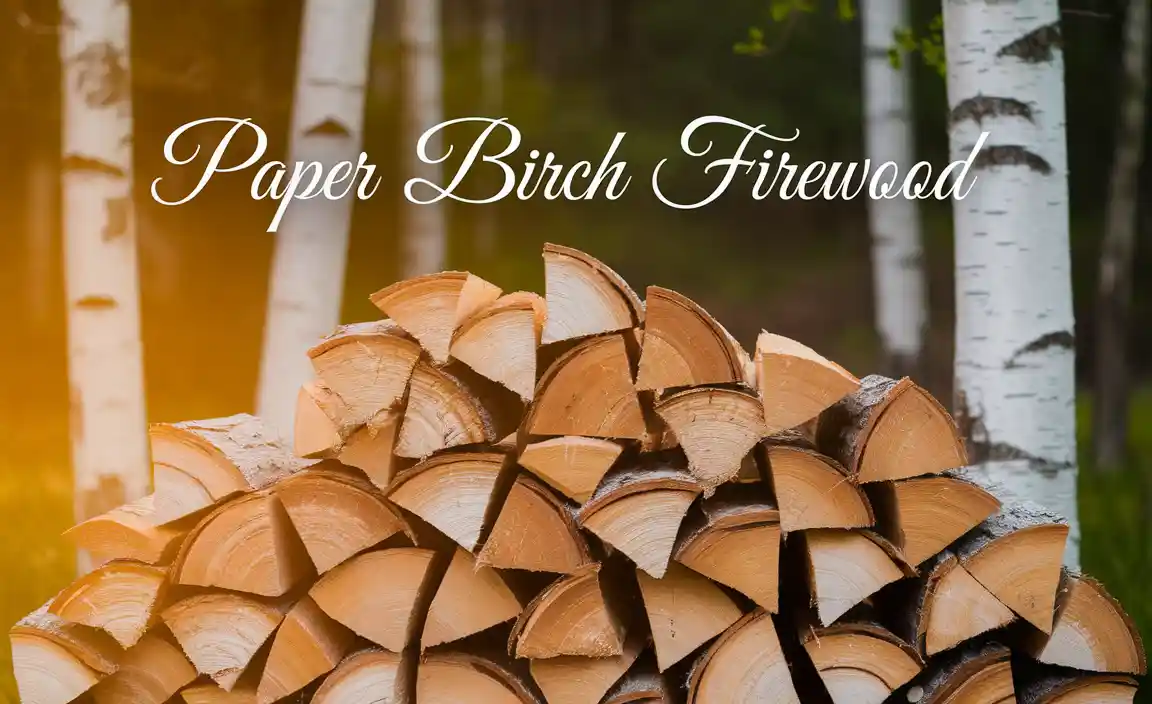Many people love a cozy fireplace, especially on chilly nights. But, is it safe to burn ash wood? This question buzzes in the minds of many who enjoy a warm glow in their homes. Imagine sitting by the fire, surrounded by family, while the flames dance brightly. What if the wood you use affects your health or the environment?
Here’s a fun fact: ash wood is not just great for furniture; it makes for a solid firewood choice too! Its hardwood burns hot and slow, perfect for a long-lasting fire. But, safety comes first. Knowing which woods are safe to burn can help you enjoy your fire worry-free.
In this article, we will dive deeper into the question of whether it is safe to burn ash wood. We’ll uncover the benefits, the risks, and what you need to know before tossing those logs onto the flames. Grab your marshmallows, and let’s explore the world of firewood together!
Table of Contents
Is It Safe To Burn Ash Wood? Understanding Its Benefits

Safe to Burn Ash Wood
Are you wondering if ash wood is safe for burning? The great news is that ash wood burns clean and hot. It produces little smoke and has a lovely scent. Many people prefer it for fireplaces and wood stoves. Ash also has low moisture content, which means it ignites easily. Just remember, like any wood, you should avoid burning treated or painted ash. With proper care, you can enjoy the warmth and ambiance ash wood provides!Understanding Ash Wood Characteristics
Density and weight of ash wood. Moisture content and its impact on burning.Ash wood is known for two main features: its density and its moisture content. It has a medium density, which makes it durable and strong. This wood is heavier than some others, helping it burn slowly and evenly. However, moisture plays a big role when burning ash. High moisture content can lead to smoke and less heat. It’s best to use seasoned ash, which has less than 20% moisture, for efficient burning.
How Does Moisture Impact Ash Wood Burning?
High moisture leads to more smoke and less warmth.- Seasoned ash: 20% moisture or less
- Unseasoned ash: Higher moisture, less heat
- Efficient burning: Try to keep it dry
Health Benefits of Burning Ash Wood
Reduced emissions compared to other types of wood. Minimal creosote buildup in chimneys.Burning ash wood has some great health benefits. First, it releases less smoke than many other types of wood, meaning you can breathe easier while cozying up by the fire. This is a win for your lungs and the environment! Less smoke also means lower emissions, keeping air clean. Plus, ash wood causes very little creosote buildup in chimneys. Less creosote means fewer fires, which is a big bonus! Who needs a chimney fire on a chilly night?
| Type of Wood | Emissions Level | Creosote Buildup |
|---|---|---|
| Ash Wood | Low | Minimal |
| Oak Wood | Moderate | Moderate |
| Pine Wood | High | High |
Environmental Considerations
Sustainability of ash wood sourcing. Effects on air quality and smoke pollution.Choosing ash wood for burning can be a smart and eco-friendly option. Ash trees are often sustainably sourced, meaning we can enjoy them without harming nature. When we burn ash wood, the smoke can cause less pollution compared to other woods. This is important because clean air helps us all stay healthy. Here are some key points:
- Sustainable sourcing protects the environment.
- Less smoke means better air quality.
- Ash wood produces low emissions.
So, using ash wood can be a win-win for both warmth and the planet!
Is burning ash wood harmful to the environment?
No, burning ash wood is not harmful if sourced properly. Properly sourced ash wood leads to lower emissions and better air quality.
Preparation and Seasoning of Ash Wood
Best practices for drying ash wood. Ideal moisture levels for optimal burning.Drying ash wood properly makes it safe to burn. First, cut your wood into small pieces. This helps it dry faster. Then, store the wood in a dry, well-ventilated area. Keep it off the ground to avoid moisture. Aim for a moisture level of around 20% or less. This level is best for burning. Seasoning may take around six months to a year. Proper preparation makes your fire safer and burns hotter!
What is the best way to dry ash wood?
The best way to dry ash wood is to cut it into smaller pieces and store it in a dry area with good air circulation.
Tips for Drying Ash Wood:
- Cut logs into smaller pieces.
- Store off the ground.
- Keep in a dry place.
- Aim for moisture levels under 20%.
Safety Tips for Burning Ash Wood
Proper ventilation and fireplace maintenance. Recommended fire safety equipment and practices.To burn ash wood safely, proper ventilation is crucial. Always ensure that your fireplace or stove has a good airflow. This helps smoke escape and keeps your space fresh. Regular maintenance of your fireplace is also important. Clean out any ash buildup and check for blockages.
Using the right fire safety equipment can protect your home. Here are some recommended items:
- Smoke detectors
- Fire extinguishers
- Carbon monoxide detectors
Practice safety by never leaving the fire unattended and keeping flammable items away from the heat source. Always have an emergency plan in place.
What should I do for fire safety when burning ash wood?
Ensure good ventilation, maintain your fireplace, and use smoke and carbon monoxide detectors.
Common Myths and Misconceptions
Debunking the myths about ash wood burning. Clarifying the differences between hardwoods.Many believe that all woods burn the same, but that’s not true! Ash wood is often surrounded by myths. One common myth is that softwoods are always better; however, hardwoods, like ash, can be just as amazing for burning. Think of hardwoods as the gym-goers of the wood world—strong and reliable! Check out the table below to see how ash wood stacks up against other types:
| Wood Type | Hardness | Burn Time | Heat Output |
|---|---|---|---|
| Ash | Hard | Long | High |
| Softwood | Soft | Short | Medium |
Next time you hear someone say ash wood isn’t safe to burn, laugh a little! It’s not only safe, but it’s also highly efficient. So go ahead and enjoy that warm fire without any worry!
Comparing Ash Wood with Other Firewoods
Ash wood vs. oak: burning efficiency and heat output. Ash wood vs. pine: smoke production and flavor profiles.Ash wood has some great qualities compared to other firewoods. Here’s a quick look at how it measures up against other types:
- Ash vs. Oak: Ash burns hotter and faster than oak. It provides more heat and less time waiting for warmth.
- Ash vs. Pine: Ash produces less smoke than pine. This means it gives off a cleaner burn and better flavor for cooking.
People often prefer ash wood for its efficiency and lower smoke. It truly stands out for both heat output and pleasant burning experience.
What makes ash wood a better choice?
Ash wood burns cleaner, providing more heat and less smoke compared to pine and oak. This makes it a top pick for both warmth and cooking.
Usage in Different Heating Systems
Compatibility with wood stoves and fireplaces. Using ash wood in outdoor fire pits.Many love to use ash wood in their heating systems. It works well in wood stoves and fireplaces. Ash wood burns evenly and efficiently, providing steady warmth. Did you know it produces less smoke? This makes it great for indoor use. For outdoor fire pits, ash wood is also a good choice. It gives off a nice flame and produces less ash. Here’s a quick look at its uses:
- Wood stoves: Burns steadily and produces little smoke.
- Fireplaces: Offers nice warmth with less creosote buildup.
- Outdoor fire pits: Creates a beautiful fire with a pleasant glow.
Is ash wood safe for heating?
Yes, ash wood is safe for heating. It burns clean and warms up spaces quickly.
How to Properly Store Ash Wood
Best storage conditions to maintain wood quality. Avoiding pests and decay during storage.To keep your ash wood in great shape, store it in a dry, cool place. A shed or garage works well. Make sure air can flow around the wood. This helps it stay dry and prevents mold. You don’t want your firewood to become a science experiment! Also, check for pests like bugs. Keeping your wood off the ground can help avoid trouble. A simple rack will do the trick!
| Best Storage Tips | Why It Helps |
|---|---|
| Store in a Dry Area | Prevents mold and decay |
| Allow Airflow | Stops moisture buildup |
| Use a Wood Rack | Keeps pests away |
| Inspect Regularly | Catch problems early |
Remember, a little care goes a long way in keeping your wood safe and sound! Happy burning!
Conclusion
In conclusion, burning ash wood is generally safe and efficient. It burns cleanly and produces little smoke. It also heats well, making it a great choice for fires. Always ensure the wood is dry before burning. We encourage you to learn more about safe wood-burning practices. Your cozy fire can be safe and enjoyable with the right knowledge!FAQs
Is Ash Wood Safe To Burn In Fireplaces And Wood Stoves?Yes, ash wood is safe to burn in fireplaces and wood stoves. It burns well, making good heat. It also produces less smoke and sparks, which keeps you safe. Just make sure it’s dry before you use it!
What Are The Benefits Of Burning Ash Wood Compared To Other Types Of Firewood?Burning ash wood has several benefits. First, it burns hot, which warms up your space quickly. Second, it produces less smoke, so it’s better for the air. Third, it’s easy to light, making it fun to start a fire. Lastly, ash wood dries quickly, so you can use it sooner.
Are There Any Specific Precautions To Take When Burning Ash Wood?Yes, there are a few precautions when burning ash wood. First, make sure the wood is dry. Wet wood can create smoke and less heat. Second, build a good fire with space for air to move. Lastly, always watch the fire and keep water nearby just in case.
How Does The Moisture Content Of Ash Wood Affect Its Safety And Efficiency When Burned?When ash wood has too much moisture, it burns poorly. This means it produces less heat and more smoke. If you burn dry ash wood, it will burn hotter and cleaner. This keeps you safer by reducing smoke and creosote, which can start fires. So, always use well-dried ash wood for the best burning experience.
Can Burning Ash Wood Release Harmful Pollutants, And How Can This Be Mitigated?Yes, burning ash wood can release harmful pollutants like smoke and chemicals. These can be bad for our health and the environment. We can help reduce the pollution by using dry wood, which burns cleaner. Make sure to burn wood in a good stove that keeps smoke inside. This way, we can enjoy warmth and stay safe!




